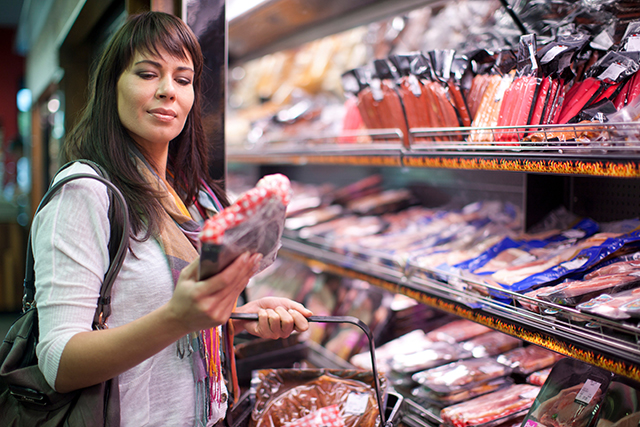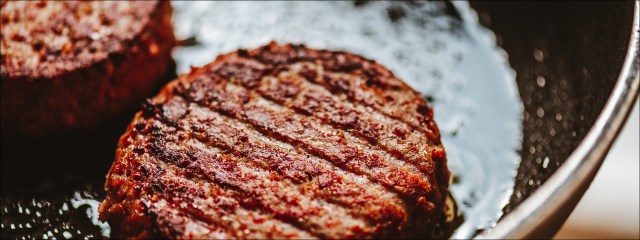Whether you’re a vegetarian, vegan, flexitarian or simply looking to cut back on the amount of meat you consume, there are a plethora of options when it comes to plant-forward eating. Check out this guide to plant-based meat alternatives and learn how you can get your daily protein requirement while keeping your health, the planet and animal welfare in mind.
How Important Is Protein?
Humans need protein; it helps build muscle tissue and strengthen bones. The amino acids in protein also make antibodies, blood, connective tissue, enzymes and hair. There are nine essential amino acids, which our bodies cannot produce and therefore must come from food.
The recommended dietary allowance for protein is a modest 0.8 grams of protein per kilogram of body weight, according to the Harvard Health blog. To determine your daily protein intake, you can multiply your weight in pounds by 0.36.
You might need slightly more or less protein depending on how active or sedentary your lifestyle is.
Benefits of Eating Less Meat
Meat may be the first thing that comes to mind when you think of protein, but it’s completely possible to get enough protein – and all nine essential amino acids – from plant-based meat alternatives.
Health Reasons
Cutting back on the amount of meat you eat can improve your health in many ways. Individuals who don’t eat meat generally consume fewer calories and weigh less, according to the Mayo Clinic.
Consuming less meat can also help lower your risk of high blood pressure and cholesterol, heart disease, obesity, stroke, type 2 diabetes and various cancers, according to the American Heart Association.
Environmental Reasons
Eating more fruits, vegetables and other plants – especially organic varieties – is better for the planet, too.
Raising livestock takes up a lot of room and resources. “If we combine pastures used for grazing with land used to grow crops for animal feed, livestock accounts for 77% of global farming land,” according to Our World in Data.
Livestock also contributes to 14.5% of all global greenhouse gas emissions, according to the Food and Agriculture Organization of the United Nations. Animal agriculture pollution occurs when animals naturally produce methane and when their waste accidentally gets into waterways.
Moral Reasons
Some people choose to go vegan or vegetarian for moral reasons. Factory farming is a major concern when it comes to the welfare of both animals and factory employees.
99% of U.S. farmed animals are living in factory farms at present, according to the Sentience Institute.
There’s also a lot of room for interpretation when it comes to “cage-free,” “free-range” and “pasture-raised” claims. “Except for ‘certified organic,’ the U.S. government does not set definitions or requirements for egg carton labels,” according to the Humane Society.
“The huge amount of antibiotics that keep animals on these farms from getting sick is leading to an abundance of drug-resistant bacteria,” according to the Humane Society of the United States. “And factory farms’ very nature – full of stressed animals, with poor sanitation – creates ideal conditions for diseases to thrive, including viruses that can infect humans.”
Recent examples are the COVID-19 outbreaks that occurred in meat and poultry processing facilities.
High-Protein Plants
One way to get your daily amount of protein is to eat a variety of meatless and nondairy foods. These include grains, legumes, nuts, seeds, vegetables and other plants.
Legumes
Legumes include beans, lentils and peas. All provide a good amount of protein while being versatile – they can go into salads and soups or be prepared in a way that resembles meat.
Legumes are “loaded with protein, iron and zinc, as you might expect from other protein sources like meat,” according to NutritionFacts.org. “Legumes also contain nutrients that are concentrated in the vegetable kingdom, including fiber, folate and potassium.”
Half a cup of cooked beans has the same amount of protein – 8 grams – as a cup of milk, according to Harvard Health Publishing. “Beans are packed with fiber, folate and phytates, which may help reduce the risk of stroke, depression and colon cancer,” according to NutritionFacts.org.
Fresh, frozen, canned and dried peas and split peas are another option. Green pea protein powder can be added to smoothies or nondairy milk for a post-workout boost. European-grown lupin (or lupine) is another natural protein powder; however, it should be avoided by those with peanut allergies.
Soy
Popular soy-based foods include tofu and tempeh.
Tofu is made from soybean curds, similar to how cheese is made. It can be soft or firm, but it is relatively bland. It takes on the flavor of what you cook it with. One 3.5-ounce serving of tofu offers 8 grams of protein and 70 calories.
Made from fermented soybeans, tempeh has a nuttier flavor than tofu. One 3-ounce serving of tempeh boasts 15 grams of protein along with calcium.
Grains, Oats and Wheat
Spelt is an ancient whole grain that’s closely related to wheat. One cup of spelt has over 10 grams of protein. It can be added to baked goods or used to make polenta, risotto, grain bowls and more. Spelt is not part of a gluten-free diet.
Teff is a grain that comes from an annual grass, making it a gluten-free option. Just 3.5 ounces of teff flour has 12 grams of protein and fiber.
Raw oats can be a good source of protein, too. 3.5 ounces of raw oats offers almost 17 grams of protein and 10 grams of fiber.
Seitan, or hydrated wheat gluten, is low-fat and low-carb while being high in protein. A 3-ounce serving contains between 15 and 21 grams of protein, according to Healthline.
Nuts, Seeds and Yeast
Nuts – like almonds, cashews, peanuts, pistachios and walnuts – might feel like just a topping or snack, but these protein powerhouses can support and flavor an entire meal in the form of peanut sauce or pesto.
Quinoa is a seed that puffs up when cooked. It can add nice texture to a dish, along with all nine essential amino acids. Quinoa has been called a superfood, boasting more fiber than brown rice as well as antioxidants and minerals, including iron, folate, magnesium and zinc.
Nutritional yeast is a golden powder that adds a cheesy flavor to dishes and thickens soups and sauces. Nutritional yeast is a complete protein that boasts B vitamins and trace minerals like manganese, molybdenum, selenium and zinc.
Vegetables
Vegetables like artichokes, asparagus, broccoli, Brussels sprouts, collards, peppers, potatoes, spinach and sweet potatoes are all good sources of protein, according to the American Heart Association.

Plant-Based Meat Alternatives
There are more plant-based meat alternatives on the market than ever before. Some options are more meat-like than others, imitating the look, taste and texture of meat with various levels of nutritional value.
Check the Nutrition Facts
When looking for a vegetarian or vegan meat alternative, always check the nutrition facts and list of ingredients. Just because a product is labeled “plant-based,” “vegan” or “vegetarian” doesn’t mean it’s healthy.
Salt is used to improve flavor and increase the shelf life of many commercial food products. Watch out for the amount of sodium, saturated fats and preservatives when shopping for meat alternatives.
Veggie Burgers
Most veggie burgers don’t try to hide their lack of meat. In leu of meat, ingredients like beans, quinoa, potatoes and tofu are used to form a patty.
You can make your own veggie burgers at home – like these black bean burgers from the blog Sally’s Baking Addiction or the New York Time’s ultimate veggie burger. Or, consider store-bought varieties like Amy’s, Hilary’s or Dr. Praeger’s. Again, make sure to check the nutrition facts, as some makers and individual flavors are healthier than others.
Beef Imitations
“Meatless burgers are a good source of protein, vitamins and minerals,” according to Harvard Health blog, adding that some meatless burgers are heavily processed and high in saturated fat.
There are a few popular meat alternative brands on the market that specialize in products that are made to imitate the look, feel and taste of real meat.
Impossible Products use a variety of ingredients to make burger, sausage and pork alternatives. There’s soy and potato for protein, heme and yeast extract for flavor, coconut and sunflower oils for fat as well as methylcellulose and food starch for binders.
Beyond Meat makes plant-based meat alternatives for meatballs, sausages, burgers and more. Protein comes from beans, peas and brown rice while cocoa butter, coconut oil and expeller-presses canola oil offer fat. Beet juice, apple extract and natural flavors make the products look like real meat. Calcium, iron, potassium chloride and salt provide flavor while carbohydrates like potato starch and methylcellulose offer structure.
Faux Chicken and Fish
Some chicken and fish alternatives are more convincing than others, but like faux beef products, you should look at nutritional info.
Products like Quorn Chik’n Cutlets and Simple Truth Meatless Grillers imitate actual chicken breasts, whiles brands like Morning Star Farms and Gardein make crispy “chicken” tenders and nuggets.
Notable faux seafood producers include Good Catch, which makes plant-based crab cakes, fish cakes, fish burgers and tuna. Similarly, New Wave is known for its plant-based shrimp.
Plants With Meaty Texture
Although they aren’t the most protein-packed plants, mushrooms and jackfruit are vegetarian meat substitutes that can add a hearty “meatiness” to otherwise meat-free dishes.
Mushrooms
Mushrooms – like button/white, cremini, maitake, oyster, portobello and shitake – are another superfood. Mushrooms are cholesterol- and fat-free as well as low in calories and sodium. They’re also packed with fiber, vitamins and minerals.
Jackfruit
Jackfruit is a popular choice among vegans and vegetarians due to its shredded meat-like texture. Jackfruit offers a decent amount of protein compared to other fruits and contains many vitamins and minerals, including vitamin A and C, copper, magnesium, manganese, potassium and riboflavin.
Looking for more ways to mix it up in the kitchen? AAA members can save on Home Chef, a subscription box that provides everything you need to create delicious meals from home, from fresh ingredients to step-by-step instructions. Plus, Home Chef offers a wide variety of vegetarian options, including Impossible Foods!
Which plant-based meat substitutes do you like to eat? Tell us in the comments.
36 Thoughts on “An Exploration of Plant-Based Meat Alternatives”
Leave A Comment
Comments are subject to moderation and may or may not be published at the editor’s discretion. Only comments that are relevant to the article and add value to the Your AAA community will be considered. Comments may be edited for clarity and length.



















“When looking for a vegetarian or vegan meat alternative, always check the nutrition facts and list of ingredients. Just because a product is labeled “plant-based,” “vegan” or “vegetarian” doesn’t mean it’s healthy.”
This should be in bold and capital letters following a warning sign especially for the line of Impossible products. The amount of saturated fat in their “ground beef” is significantly higher than what is found in actual lean ground beef whereas certain cuts of chicken has none (tenderloins).
I love the beyond products. I have bought the meatballs and the burgers. I am going to make bacon cheeseburgers out of the burgers and an Italian meal out of the meatballs. I know bacon should be rolled out but as it occasional treat it’s OK. I hope Costco never sub selling their beyond products. The only product so I have seen are the burgers and the meatballs I sure would like To buy the sausages if I can find them.
I like eggplant a lot which wasn’t mentioned as an alternative in the article. Avocados are something I eat a lot also. I very slowly cut down on eating meat, quiting breakfast meat, then cold cuts. I believe in all 3 reasons for cutting down on meat intake health, environmental and moral.
In the section of the article entitled “Nuts, Seeds and Yeast” The author rice the following:
“Nuts – like almonds, cashews, peanuts, pistachios and walnuts – might feel like just a topping or snack, but these protein powerhouses can support and flavor an entire meal in the form of peanut sauce or pesto.”
To the best of my knowledge peanuts are not nuts, but beans/Legumes
Thank you for mentioning the horrors of factory farming that is cruel and inhumane. The treatment of the animals during their short lives as well as when they are “brought to market” are horrific as are the working conditions of the employees who work at these ghastly facilities.
I went vegetarian due to gout – the drugs help, but if I eat more than a little meat, I get an attack (= 2 weeks not able to walk). I really like Impossible (Impossible Whopper) and Beyond (Beyond sausage from Dunkin and Starbucks) products, but for day to day I use Morningstar and Gardein products, as well as Trader Joe’s vegetarian/vegan products.
Any info on Burger King’s Impossible Whopper?
Not sure I’d recommend for its nutritional value, but it sure tastes delicious, like the real thing – with all the fixins.
I have been a vegetarian for over 40 years. The best plant based burger I have eaten is called Field Roast. They also make 3 varieties of sausage which are delicious as well!
I second the Field Roast recommendation. I eat mostly vegan/vegetarian yet have a soy allergy, not a fun combination, and I find Field Roast offers the best soy-less sausages and burgers on the market. Especially the burgers – they are one of the best for cooking over a grill that I’ve found.
Great article thank you!!!! I also loved the complete burger, I think it’s a fairly new kid on the block, so delicious though…
We like impossible burger the best for a burger alternative. We’ve tried many alternatives and we feel this one tastes the best.
What options are there for low sodium? I havent found any in the market yet.
I’m not sure how low you need to go, but “No Evil” products and “Sweet Earth” seitens are in the 300mg per serving range and taste good
Quorn products are fabulous! They are made from a fungus based micro-protein. It is soy free and there are no GMO ingredients.
I’ve been vegetarian since 1975. For me, being able to occasionally eat a beyond meat burger is fantastic. It tastes exactly like the burgers I remember from 45 years ago!
Because of a significant allergy profile, I am very wary of trying anything that combines foods to imitate other foods. Easier and safer to just eat less meat.
Sadly, the Impossible Company uses Monsanto’s GMO-laced Soy. Stick with Beyond if you want a Burger that non-GMO.
This was a very good article on meatless products. I use many of these products you mentioned. Gardein is particularly good. Also have had the “impossible burgers”, etc.
Thanks Anne and great catch, you’re right, it was indeed a typo.
This is a very good article and I learned a lot. You did not mention that some of the meat alternatives use GMO products and the potential health consequences of consuming non-naturally grown foods. I think that is important to note since this was an article on staying healthy.
There is absolutely nothing you eat nowadays that hasn’t been modified (how do you think all those different kinds of apples or tomatoes came into being?).GMO just means that they are able to be more efficient & successful with their modifications as opposed to manually combining strains. It’s not some sort of acronym for evil.
Hi, Brian. GMOs are prevalent in a lot of foods, however heirloom fruits and vegetables as well as organic products/foods cannot contain genetically modified organisms. See here for more information.
Thank you for reading and commenting.
Hooray! A calm voice in the universe.
Brian, organic produce has not been genetically modified like arctic apples, GMO potatoes, BT corn, etc. I choose not to tempt fate with often inadequately evaluated GMO products which are specific as opposed to those labeled Non GMO or organic.
very informative
Impossible burgers and loose “meat” blocks are the best faux hamburger that I’ve tasted so far. The Alpha Foods plant protein Crispy Chix patties are excellent but are a little high in sodium, so one is enough! I haven’t had any meat (and only a tiny bit of dairy) in almost two months. I lost about seven pounds without really trying, and I really feel much better. I have more energy, less bloat, better digestion, and at the end of the day, I sleep better! Start with meatless Mondays, then add another day per week!
Great suggestion! I’ll try meatless Mondays and move from there.